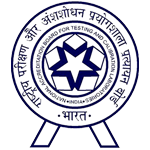Padmashree Dr.(Prof.) D.S. Rana,
Chairman Board of Management & Deptt of Nephrology
Dr Suruchi Sinha,
Deputy Medical Superintendent
Sir Ganga Ram Hospital is a 675-bedded Tertiary Care, State-of-the-art Hospital in India. The hospital was founded initially in 1921 at Lahore by Sir Ganga Ram (1851-1927), a civil engineer and leading philanthropist of his times. The foundation stone was laid in April 1951 by Late. Prime Minister of India Shri Jawahar Lal Nehru. It provides comprehensive Healthcare services, and has acquired the status of a premier Medical Institution.
It continues to maintain its charitable character in accordance to the wishes of its founder. Funds generated from the hospital services are partially utilised for providing free health care to the poor and needy patients.
The Quality team adapts a holistic approach to long-term success that views continual improvement in all aspects of an organization as a process and not as a short-term goal. It aims to radically transform the organization through progressive changes in the attitude, practice, structure, and system keeping patient first and patient safety as its ultimate objective.
"IT's not about perfect. It's about effort and when you implement that effort into your life….Every single day, that's where transformations happen. That's how change occurs. Keep going remember why you started …..
Jillian Michaels
| Cardio Pulmonary Resuscitation Committee |
Code Orange-Medical Emergency Paediatric |
*5777 |
| Dr. B.K. Rao, Chairperson |
Chairperson - Deptt. of Critical Care & Emergency Medicine |
Paediatric ICU Registrar on Duty |
| Dr. Reena Kumar |
A.D.M.S |
Nursing Supervisor |
| Dr. Ashwini Mehta |
Sr. Consultant, Cardiology |
Nursing Supervisor |
| Dr. Suresh Gupta |
Sr. Consultant, Paediatrics |
DMS on Duty |
| Dr. Debashish Dhar |
Sr. Consultant, Paediatrics |
ECG Technician |
| Dr. Jyoti |
DMS & In-charge - Quality |
Telephone Exchange |
| Ms. Usha Pandey |
Chief Nursing Officer |
|
| Code Blue-Cardiopulmonary Arrest |
*5111 |
Code Indigo-Medical Emergency Neonatal |
*5999 |
| ICU Consultant |
Neonatology ICU Registrar on duty |
| ICU Registrar |
Nursing Supervisor |
| Cardiology Registrar |
Nursing Supervisor |
| DMS On duty |
DMS on duty |
| Nursing Supervisor |
ECG Technician |
| Telephone Exchange |
Telephone Exchange |
Crash Trolly

Standardized List of Crash Cart – Uniform in all locations
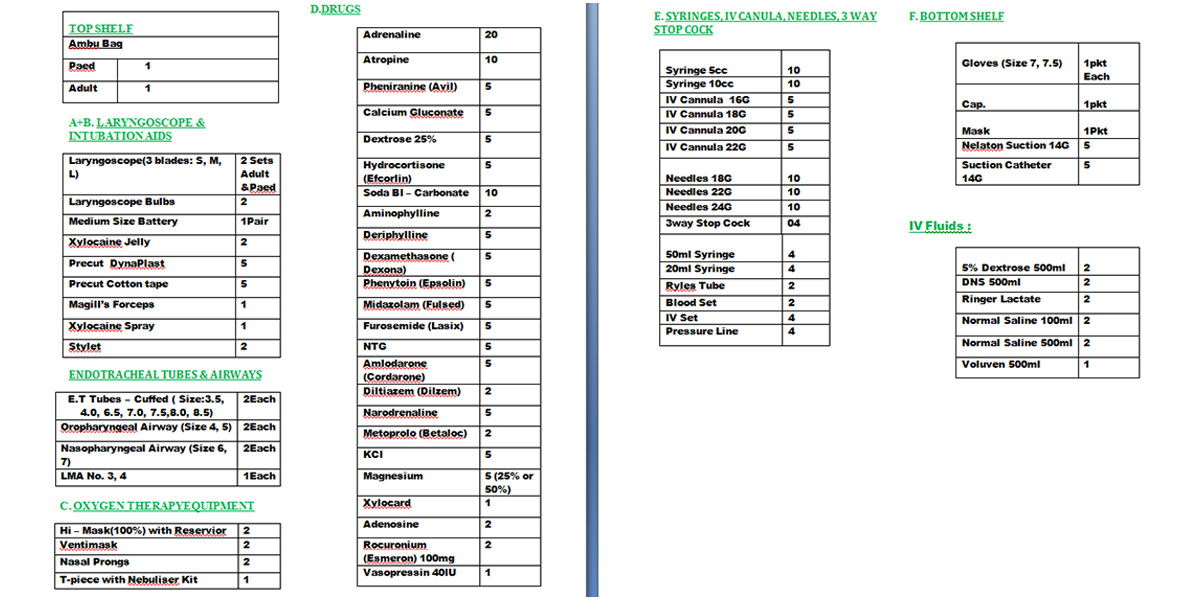
BLS Training
| BLS Training 2015/2016/2017 |

ACLS Training
| ACLS Training 2015/2016/2017 |

Code Blue Performa

Six Sigma Tools - DMAIC

Code Blue activated vs. Cardio Pulmonary Respiratory Arrest


Code Blue team arrive within 3min
| Discharged after ROSC(%) |
| |
Apr |
May |
Jun |
Jul |
Aug |
Sep |
Oct |
Nov |
Dec |
Jan |
Feb |
Mar |
Average (%) |
| 2015-16 |
92.86% |
100% |
88.24% |
100% |
100% |
50% |
66.67% |
100% |
92.86% |
82.61% |
90.91% |
87.50% |
87.64% |
| 2016-17 |
84.60% |
81.25% |
100% |
86.67% |
85% |
93.75% |
80.00% |
100% |
100% |
100% |
100% |
94% |
92.89% |
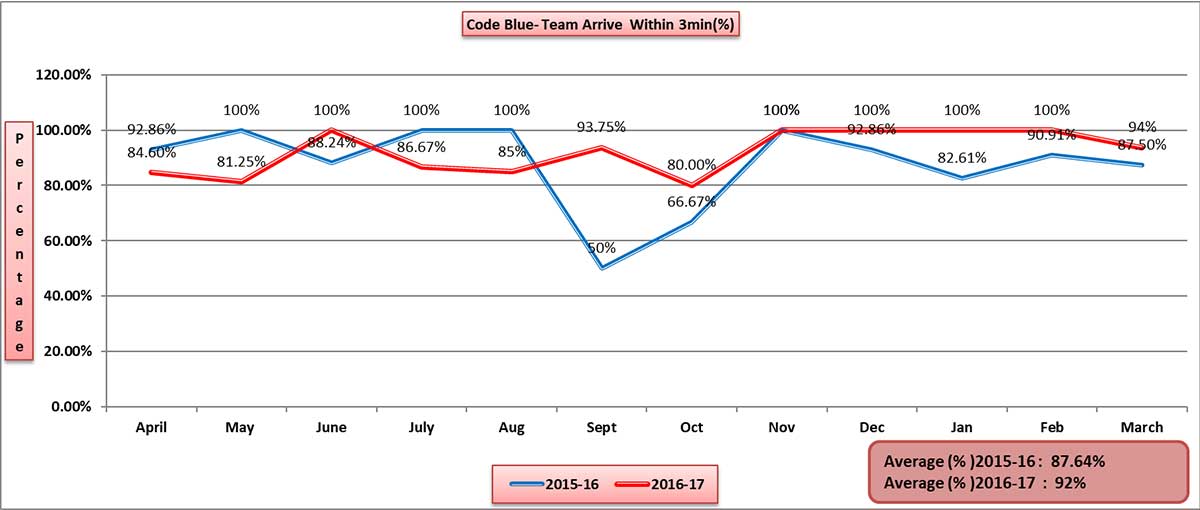
Return of spontaneous circulation (ROSC) after CPR
| Discharged after ROSC(%) |
| |
Apr |
May |
Jun |
Jul |
Aug |
Sep |
Oct |
Nov |
Dec |
Jan |
Feb |
Mar |
Average (%) |
| 2015-16 |
44.4% |
42.9% |
30.0% |
33.3% |
20.0% |
0.0% |
0.0% |
33.3% |
57.1% |
33.3% |
35.7% |
54.5% |
32.10% |
| 2016-17 |
45.5% |
50.0% |
14.3% |
41.7% |
33.3% |
46.7% |
46.7% |
30.8% |
16.7% |
36.4% |
63.6% |
40.0% |
38.60% |

Discharged after ROSC
| Discharged after ROSC(%) |
| |
Apr |
May |
Jun |
Jul |
Aug |
Sep |
Oct |
Nov |
Dec |
Jan |
Feb |
Mar |
Average (%) |
| 2015-16 |
0.0% |
14.3% |
20.0% |
16.7% |
0.0% |
0.0% |
50.0% |
16.7% |
14.3% |
19.0% |
14.3% |
9.1% |
14.50% |
| 2016-17 |
27.3% |
28.6% |
57.1% |
16.7% |
22.2% |
40.0% |
22.0% |
15.4% |
50.0% |
36.4% |
18.2% |
33.3% |
30.60% |
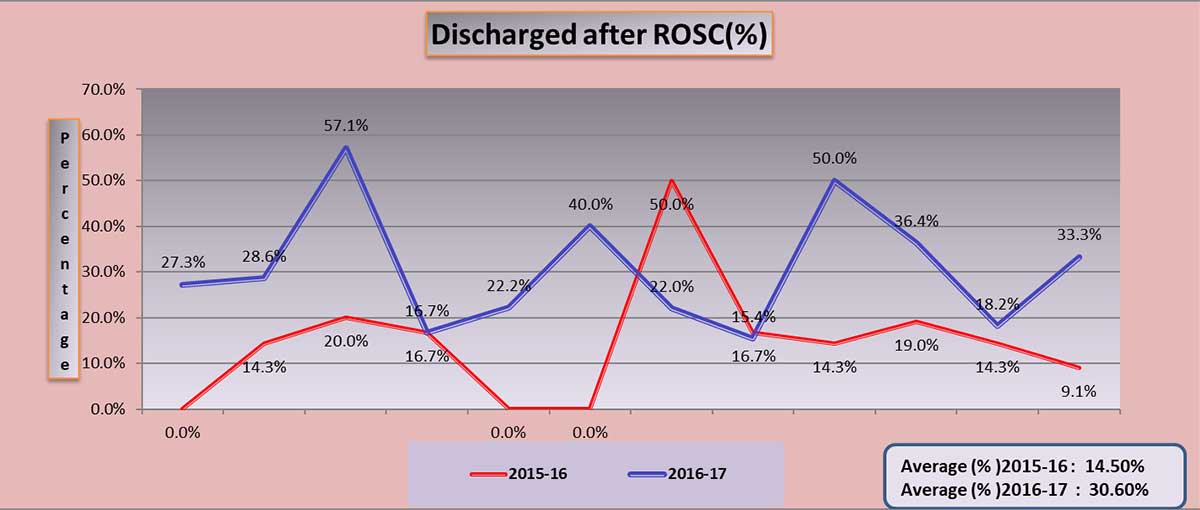
Logistic Checklist -Code Blue Performa 2015/2016/2017
| 13 |
Was staff able to readily locate/operate the following: |
Available, and was used |
Available, but not used on the patient |
Available, but defective |
Not Available |
| |
a)Emergency Medicines |
|
|
|
|
| |
b)Defibrillator |
|
|
|
|
| |
c)Laryngoscope |
|
|
|
|
| |
d)Ambu bag |
|
|
|
|
| |
e)Oxygen Cylinder (filled or not) |
|
|
|
|
| |
f)Suction machine & suction catheter |
|
|
|
|
| |
g)Glucometer |
|
|
|
|
Logistic Checklist Code Blue Performa
| Logistic Checklist Code Blue Performa 2015,2016,2017 |
| |
Ambu Bag |
Laryngoscope & intubation |
Defibrillator |
ET tube & Airways |
O2 therapy |
Emergency Medicines |
Others( |
| Non-compliance (%) |
0.5 |
0.3 |
0.3 |
0.0 |
0.5 |
0.3 |
2.5 |
| Compliance (%) |
99.5 |
99.7 |
99.7 |
100.0 |
99.5 |
99.7 |
97.5 |
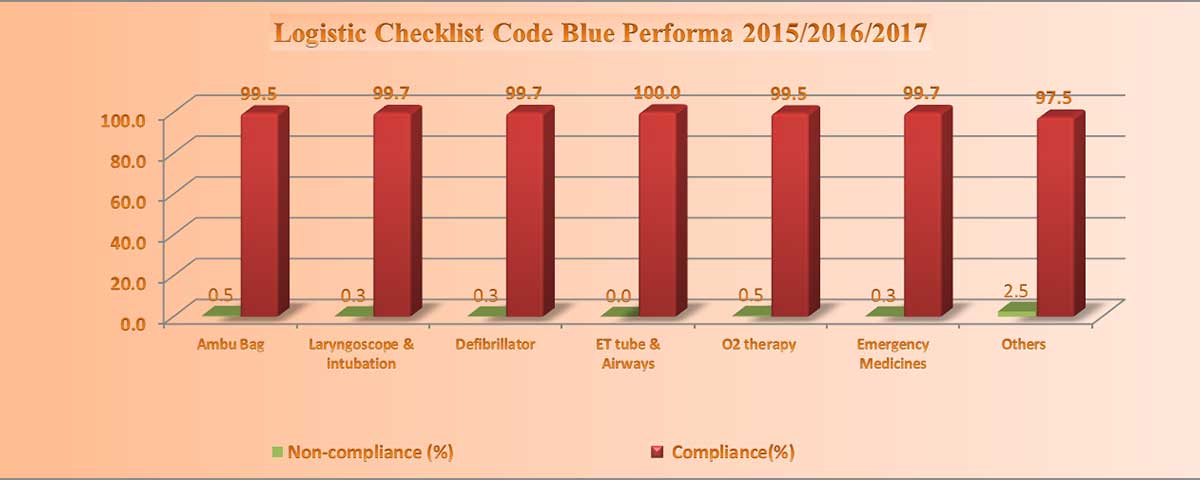
Glossary
Basic Life Support (BLS): Emergency treatment of a victim of cardiac or respiratory arrest through cardiopulmonary resuscitation and emergency cardiovascular care.
Code Blue: A declaration of or a state of medical emergency and call for medical personnel and equipment to attempt to resuscitate a patient especially when in cardiac arrest or respiratory distress or failure.
CPR: A basic emergency procedure for life support, consisting of mainly manual external cardiac massage and some artificial respiration.
Cardiac arrest: Defined as the cessation of cardiac mechanical activity as confirmed by lapse in circulation, which was determined by the absence of a palpable central pulse.
Continual Quality Improvement: CQI is serial experimentation (the scientific method) applied to everyday work to meet the needs of those we serve and improve the services we offer.
Return of Spontaneous Circulation (ROSC): is resumption of sustained perfusing cardiac activity associated with significant respiratory effort after cardiac arrest
References
In-hospital cardiac arrest is an emergency situation that requires teamwork and appropriate sequential actions to rescue the patients.[1] Despite considerable efforts to improve the treatment of cardiac arrest, most reported survival outcome figures are poor.[2] Even in the hospitalised patients, the rate of successful CPR has been reported by some studies to be as low as 2–6%, although most studies report successful CPR outcome in the range of 13–59%.[3,4]
Very few studies are available in the literature on comparative CPR outcomes after formal resuscitation training. An in-hospital investigation demonstrated that cardiac arrest detected by an ACLS-trained nurse was strongly associated with a four-fold increase in survival to discharge. (38% vs. 10%) than those detected by a nurse without ACLS training.[5] This indicates that ACLS-trained nurses provided an independent contribution to increased survival rate.
Study by Saket Girotra, for the American Heart Association Get with the Guidelines–Resuscitation Investigators in “Trends in Survival after In-Hospital Cardiac Arrest “shows that the overall rate of survival to discharge improved significantly from 13.7% in 2000 to 22.3% in 2009. [6]
Conclusion
Successful resuscitation after cardiac arrest requires early recognition of cardiac arrest, rapid activation of trained responders, timely initiation of BLS, early defibrillation and early ACLS.[7].Our study reveals that availability of logistics at all locations with formal training of the CPR team will drastically improve the survival rates and survival to hospital discharge rates following resuscitation of cardiac arrest victims. The Quality Initiative under taken reinforces that formal certified BLS and ACLS training/retraining with hands-on practice with periodic renewal are crucial in improving the outcomes of ROSC and Survival rate
Bibilography
- Krittayaphong R, Saengsung P, Chawaruechai T, Yindeengam A, Udompunturak S. Factors predicting outcome of cardiopulmonary resuscitation in a developing country: The Siriraj cardiopulmonary resuscitation registry.J Med Assoc Thai. 2009;92:61823.[PubMed]
- Jacobs I, Nadkarni V, Bahr J, Berg RA, Billi JE, Bossaert L, et al. Cardiac arrest and cardiopulmonary resuscitation outcome reports: update and simplification of the Utstein templates for resuscitation registries. A statement for healthcare professionals from a task force of the international liaison committee on resuscitation. (American Heart Association, European Resuscitation Council, Australian Resuscitation Council, New Zealand Resuscitation Council, Heart and Stroke Foundation of Canada, InterAmerican Heart Foundation, Resuscitation Council of Southern Africa) Resuscitation. 2004;63:233–49. [PubMed]
- Borimnejad L, Nasrabadi AN, Mohammadi H, Kheirati L. Improving the outcomes of CPR: A report of a reform in the organization of emergency response. Internet J Emer Med. 2008;4:2.
- Berger R, Kelley M. Survival after in-hospital cardiopulmonary arrest of noncritically ill patients. Chest. 1994;106:872–9. [PubMed]
- Dane FC, Russell-Lindgren KS, Parish DC, Durham MD, Brown TD. In-hospital resuscitation: Association between ACLS training and survival to discharge. Resuscitation. 2000;47:83–7. [PubMed]
- Saket Girotra, M.D., Brahmajee K. Nallamothu, M.D., M.P.H., John A. Spertus, M.D., M.P.H., Yan Li, Ph.D., Harlan M. Krumholz, M.D., and Paul S. Chan, M.D., for the American Heart Association Get with the Guidelines–Resuscitation Investigators.
- Doig CJ, Boiteau PJ, Sandham JD. A 2-year prospective cohort study of cardiac resuscitation in a major Canadian hospital. Clin Invest Med. 2000;23:132–43. [PubMed]













